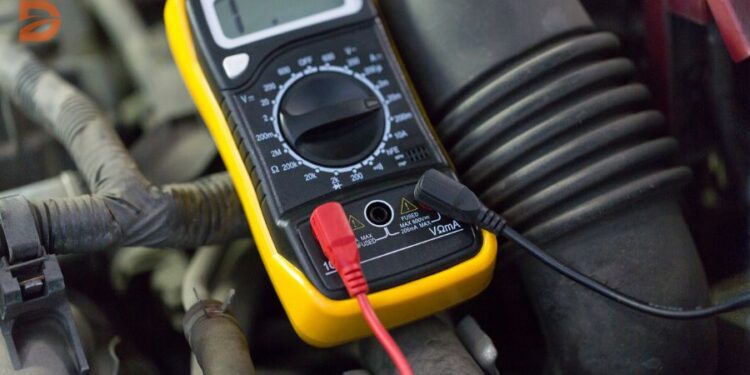In today’s high-tech world, our cars have become increasingly sophisticated, packed with complex electronic systems that can make it challenging for the average driver to diagnose and fix issues on their own. However, investing in a few essential car diagnostic tools can empower you to take control of your vehicle’s health, save time and money on repairs, and maintain optimal performance. From advanced OBD2 scanners to versatile multimeters, this article will explore the must-have diagnostic tools every driver should consider.
So, what are the essential car diagnostic tools that can transform your DIY maintenance and repair experience? Let’s dive in and uncover the tools that can help you become a more informed and self-reliant driver.
Key Takeaways
- Diagnostic tools empower drivers to identify and address vehicle issues quickly, saving time and money on expensive repairs.
- A comprehensive toolset includes essential items like OBD2 scanners, code readers, multimeters, and specialized tools for in-depth diagnostics.
- Proactive maintenance using diagnostic tools can help extend the lifespan of your vehicle and ensure optimal performance.
- Investing in the right diagnostic tools can make DIY car care more accessible and rewarding for drivers of all skill levels.
- Staying up-to-date with the latest diagnostic technology can help you keep pace with the evolving complexity of modern vehicles.
Understanding Car Diagnostic Tools
Modern vehicles are equipped with sophisticated onboard diagnostics (OBD) systems that monitor various vehicle components and report any issues through diagnostic trouble codes. The OBD-II port, introduced in 1996, provides a standardized interface for accessing these codes and other diagnostic data. Understanding the importance of on-board diagnostics and the different types of diagnostic tools available, such as scanners, code readers, and multimeters, is crucial for effectively maintaining and troubleshooting a vehicle.
The Importance of On-Board Diagnostics
The onboard diagnostics system in modern vehicles serves as the backbone for identifying and resolving issues. These systems continuously monitor various components, from the engine and transmission to the electrical systems and emissions. By accessing the OBD-II port, diagnostic tools can retrieve trouble codes and other essential data, enabling mechanics and car owners to quickly identify and address problems before they escalate.
The Variety of Diagnostic Tool Types
When it comes to car diagnostics, there is a range of tools available to suit different needs and budgets. Scanners are comprehensive diagnostic devices that can read and clear trouble codes, as well as provide detailed information about the vehicle’s systems. Code readers offer a more basic functionality, focusing on trouble code retrieval and clearing. Multimeters are versatile tools that can measure electrical parameters, such as voltage, current, and resistance, which is crucial for diagnosing electrical and electronic issues.
“Understanding the importance of on-board diagnostics and the different types of diagnostic tools available is crucial for effectively maintaining and troubleshooting a vehicle.”
By leveraging the power of these diagnostic tools, car owners and mechanics can quickly identify and address issues, saving time and money in the long run. Whether it’s a simple code reader or a more advanced scanner, having the right diagnostic tools in your automotive toolkit can make a significant difference in the overall health and performance of your vehicle.
OBD2 Scanner: The Ultimate Diagnostic Tool
At the pinnacle of automotive diagnostic tools, the OBD2 scanner stands out as the ultimate solution for comprehensive vehicle analysis. This advanced device plugs directly into the OBD-II port, granting direct access to the vehicle’s computer system and a wealth of diagnostic data.
OBD2 scanners offer a multitude of functions that make them indispensable for both professional mechanics and diligent car owners. These tools can read and clear diagnostic trouble codes, providing valuable insights into the vehicle’s performance and any existing issues. Furthermore, they can display live data from various sensors and systems, allowing users to monitor the vehicle’s vitals in real time.
Beyond basic diagnostic capabilities, OBD2 scanners can also perform advanced functions such as coding and programming. This makes them essential for comprehensive vehicle maintenance and troubleshooting, enabling users to delve deep into the car’s inner workings and address complex problems.
The versatility of OBD2 scanners is truly remarkable. From simple handheld devices to sophisticated, ruggedized tools used by professional mechanics, these scanners come in a wide range of shapes, sizes, and capabilities. Some even feature wireless Bluetooth connectivity, allowing users to access diagnostic data through compatible mobile apps.
When selecting an OBD2 scanner, it’s crucial to ensure compatibility with the specific make and model of the vehicle. With different protocols used by various OBD-II systems, compatibility is a key consideration, especially for hybrid and electric vehicles. Ensuring a proper fit is essential for accurate and reliable diagnostics.
The cost of OBD2 scanners can vary significantly, ranging from budget-friendly code readers priced around $25 to advanced diagnostic tools used by professionals, which can cost upwards of $100. However, the investment in a quality OBD2 scanner can pay dividends in the long run, providing invaluable insights and the ability to maintain and troubleshoot vehicles effectively.
| Metric | Value |
|---|---|
| Average Detailed Seller Rating for Accurate Description | 4.8 out of 5 |
| Average Detailed Seller Rating for Reasonable Shipping Cost | 5.0 out of 5 |
| Average Detailed Seller Rating for Shipping Speed | 5.0 out of 5 |
| Average Detailed Seller Rating for Communication | 5.0 out of 5 |
| Number of Seller Feedback | 6,906 |
| Percentage of Positive Seller Feedback in the Last 6 Months | 100% |
| Price of OBD2 Scanner | $187.17 |
| Number of Items Sold | 1,772 |
| Quantity Available | More than 10 |
| Shipping | Free standard shipping |
| Return Policy | 60 days returns with the seller paying for return shipping |
In conclusion, the OBD2 scanner is the ultimate diagnostic tool, providing in-depth access to a vehicle’s computer system and unlocking a wealth of information for effective maintenance and troubleshooting. Whether a professional mechanic or a diligent car owner, an OBD2 scanner is an essential tool for comprehensive vehicle diagnostics and care.
Code Reader: A Simplified Diagnostic Solution
For drivers who don’t require the full capabilities of an OBD2 scanner, a code reader can be a more affordable and user-friendly diagnostic solution. Code readers plug into the OBD-II port and provide the ability to read and clear diagnostic trouble codes, often displayed as numeric codes that can be referenced against online databases or manuals. This can help drivers quickly identify the source of a Check Engine light or other warning indicators, without the need for the in-depth analysis provided by a full-featured scanner.
Benefits of a Code Reader
A code reader offers several key advantages for drivers:
- Cost-effective solution for basic diagnostic needs
- Easy to use, with plug-and-play functionality
- Provides access to diagnostic trouble codes to pinpoint issues
- Allows users to clear codes and reset warning lights
- Compact and portable for use in various vehicles
While a code reader may not offer the comprehensive diagnostics of an OBD2 scanner, it can be a valuable tool for drivers who want to quickly address common problems and maintain their vehicle’s health. By identifying and clearing diagnostic trouble codes, a code reader can help save time and money, making it a practical solution for many car owners.
| Feature | ANCEL X7 OBD2 Scanner |
|---|---|
| Price | $369.99 |
| Maintenance Functions | 10 (including ABS, Oil, EPB, and DPF reset) |
| Vehicle Compatibility | Diverse makes and models |
| Real-Time Data | Engine temperature, RPM, sensor readings |
| Diagnostic Capabilities | Advanced beyond basic code deciphering |
| User Interface | User-friendly for novices and professionals |
| Connectivity | Built-in Wi-Fi for software updates |
| Key Functions | Diagnose and reset fault codes |
While a code reader may not offer the comprehensive diagnostics of an OBD2 scanner, it can be a valuable tool for drivers who want to quickly address common problems and maintain their vehicle’s health. By identifying and clearing diagnostic trouble codes, a code reader can help save time and money, making it a practical solution for many car owners.
Multimeter: A Versatile Electrical Diagnostic Tool
When it comes to diagnosing electrical issues in your vehicle, a multimeter is an indispensable tool. This compact device allows you to measure factors like resistance, voltage, and continuity, helping you pinpoint faulty circuits, battery problems, and sensor malfunctions. Multimeters are not only affordable but also highly versatile, making them a must-have item in any DIY garage or mechanic’s toolkit.
Digital multimeters offer several advantages over their analog counterparts. They provide higher accuracy, thanks to their advanced internal circuitry, and have a high input impedance, which prevents damage to sensitive electronic components during testing. Many general-purpose digital multimeters are user-friendly and suitable for a wide range of simple electrical measurements, with some models offering a count capacity of up to 20,000 counts for enhanced versatility.
The importance of a multimeter in automotive electrical diagnostics cannot be overstated. Mechanics rely on these tools to check battery voltage and troubleshoot complex electrical systems, while homeowners and DIY enthusiasts use them for electrical repairs and installations. Additionally, multimeters are essential in various industries, from industrial maintenance to HVAC and renewable energy systems, where they play a crucial role in monitoring and maintaining complex machinery and equipment.
When selecting a multimeter for your car diagnostics needs, look for a model with a large, easy-to-read digital display that will ensure visibility during your troubleshooting efforts. With the right multimeter in your toolbox, you’ll be well-equipped to tackle a wide range of electrical diagnostics, from tracking down resistance issues to identifying voltage problems and sensor issues.
Car diagnostic tools, maintenance essentials
In addition to the core diagnostic tools like OBD2 scanners and multimeters, several other essential maintenance items can greatly aid in identifying and resolving vehicle issues. These specialized tools can complement the capabilities of your standard diagnostic equipment, providing a more comprehensive understanding of your vehicle’s overall condition.
Paint Thickness Gauge
A paint thickness gauge is an invaluable tool when inspecting used cars. This device can reveal poor bodywork or hidden damage, helping you uncover any issues that may have been covered up. By measuring the paint depth, you can identify areas that have been repainted, potentially indicating previous collisions or poor repair work. This information can be crucial when negotiating the price of a used vehicle and ensuring you’re not buying a car with underlying structural problems.
Fuel and Vacuum Pressure Gauges
Monitoring the fuel pressure and vacuum pressure of your vehicle’s systems can provide valuable insights into the health of your fuel system and engine. Fuel pressure gauges can help diagnose issues like clogged fuel filters, faulty fuel pumps, or leaks in the fuel line. Vacuum pressure gauges, on the other hand, can be used to identify problems with the engine’s intake system, such as vacuum leaks or issues with the throttle body. These specialized tools can be particularly useful when troubleshooting fuel system issues or investigating body damage that may be affecting the vehicle’s performance.
By incorporating a paint thickness gauge, fuel pressure gauge, and vacuum pressure gauge into your diagnostic toolkit, you can gain a more comprehensive understanding of your vehicle’s condition and address any underlying problems before they escalate into more serious and costly repairs.
Specialized Diagnostic Tools
For more in-depth car diagnostics, specialized tools can provide invaluable insights. Two such essential tools are the compression tester and the combination of an inspection camera and a non-contact thermometer.
Compression Tester
A compression tester allows mechanics to directly measure the compression pressure within each engine cylinder. This is crucial for identifying issues like worn piston rings or valve problems that can impact engine performance. By identifying uneven compression across cylinders, a compression test can pinpoint the source of engine issues that may not be easily accessible or visible.
Inspection Camera and Non-Contact Thermometer
Accessing inaccessible areas of a vehicle can be a challenge during diagnostics. An inspection camera enables mechanics to visually inspect hard-to-reach components, capturing images and video footage to aid in diagnosis. Paired with a non-contact thermometer, they can also measure temperatures in various parts of the engine and systems, further enhancing the diagnostic process.
These specialized tools provide mechanics with a deeper understanding of a vehicle’s condition, empowering them to make informed decisions and deliver more accurate repairs.
Essential Diagnostics for Used Car Buyers
Purchasing a used vehicle is a major investment that requires thorough inspection and diagnostics to ensure you’re making a wise decision. By utilizing essential tools like a code reader, paint thickness gauge, and VIN decoder, you can uncover potential issues with the engine, body, and vehicle history before signing on the dotted line.
A code reader is an invaluable tool for identifying any engine problems or malfunctions. It can plug directly into the vehicle’s onboard diagnostics (OBD2) port, providing detailed information about trouble codes and allowing you to assess the overall health of the engine. This can help you negotiate a fair price or walk away from a vehicle with underlying issues.
- Utilize a paint thickness gauge to inspect the vehicle’s body for signs of previous accident damage or improper repairs. Significant variations in paint depth can indicate hidden structural problems.
- A VIN decoder enables you to access the vehicle’s history, including past accidents, owners, and potential issues. This information can be crucial in determining the true value and condition of the used car.
By taking the time to conduct these essential used car inspections, you can save yourself from unexpected repair costs down the road and ensure you’re making a sound investment. Don’t overlook the importance of thorough diagnostics when purchasing a pre-owned vehicle.
Conclusion
Equipping yourself with the right car diagnostic tools can be a game-changer for drivers who want to maintain their vehicles’ performance, save money on repairs, and tackle DIY projects with confidence. From advanced OBD2 scanners to specialized tools like compression testers and inspection cameras, the diagnostic solutions explored in this article can provide valuable insights into a vehicle’s condition and help identify issues before they become major problems.
Whether you’re a seasoned mechanic or a car enthusiast looking to learn more about your ride, these essential car diagnostic tools and maintenance essentials are crucial for keeping your vehicle running smoothly and optimizing its performance. By incorporating regular DIY repair and diagnostic checks into your routine, you can save time and money in the long run while ensuring your car remains in top condition.
Whether you’re in the market for a used car or simply want to stay on top of your current vehicle’s health, these essential diagnostic tools can provide the insights you need to make informed decisions and keep your ride running like new. With the right tools and a proactive approach to maintenance, you can enjoy a reliable, high-performing vehicle and the peace of mind that comes with it.
FAQ
What are the key car diagnostic tools every driver should have?
The essential car diagnostic tools include OBD2 scanners, code readers, multimeters, paint thickness gauges, fuel and vacuum pressure gauges, compression testers, inspection cameras, and non-contact thermometers.
Why is understanding on-board diagnostics important for vehicle maintenance?
On-board diagnostics (OBD) systems monitor various vehicle components and report issues through diagnostic trouble codes. Understanding OBD and the different diagnostic tool types is crucial for effective vehicle maintenance and troubleshooting.
What are the benefits of using an OBD2 scanner?
OBD2 scanners provide in-depth access to the vehicle’s computer system, allowing users to read and clear diagnostic trouble codes, display live data, and perform advanced functions like coding and programming.
How can a code reader help with vehicle diagnostics?
Code readers plug into the OBD-II port and provide the ability to read and clear diagnostic trouble codes, helping drivers quickly identify the source of a Check Engine light or other warning indicators.
What makes a multimeter an essential tool for electrical diagnostics?
A multimeter can measure resistance, voltage, and continuity, helping to identify faulty circuits, battery problems, and sensor issues in a vehicle’s electrical system.
What other specialized diagnostic tools can be useful for vehicle maintenance?
Specialized tools like paint thickness gauges, fuel and vacuum pressure gauges, compression testers, inspection cameras, and non-contact thermometers can provide valuable insights into a vehicle’s condition and help diagnose a wide range of problems.
How can diagnostic tools help when buying a used car?
Using tools like a code reader, paint thickness gauge, and VIN decoder can help uncover potential issues and hidden damage during a used car inspection, saving buyers from unexpected repair costs down the road.











